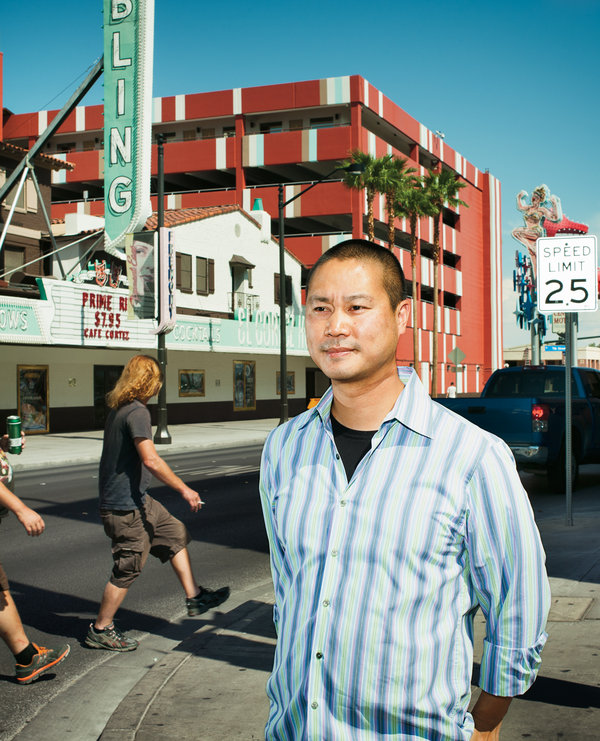Advertisement
Continue reading the main story  Tony Hsieh, the chief executive of Zappos, on Fremont Street in downtown Las Vegas.Credit…Brian Finke for The New York Times
Tony Hsieh, the chief executive of Zappos, on Fremont Street in downtown Las Vegas.Credit…Brian Finke for The New York Times
By Timothy Pratt
- Oct. 19, 2012
The mountain-lodge gathering felt like an annual shareholders’ meeting, with department heads offering optimistic forecasts backed by charts, graphs and photos. Except that the 50 or so attendees wore jeans and sneakers and sat at round tables in a faux log cabin 7,700 feet above sea level and at least 20 degrees cooler than the Nevada desert below. And what they were discussing was not a corporation but a very unusual project.
Tony Hsieh, the 38-year-old chief executive of Zappos, had called the 24-hour retreat as a debriefing of sorts. It was almost a year into the Downtown Project, his $350 million urban experiment to build “the most community-focused large city in the world” in downtown Las Vegas — an area dominated by bare lots and check-cashing stores about an hour’s drive away. An icebreaker kicked off the event with whoops and hollers as each attendee stood up to share personal anecdotes or facts, like “I’ve tried chicken-fried steak in more than 30 states.” One woman announced that she had been a salsa dancing champion. Hsieh (pronounced shay) shared how to write his last name in Morse code.
A jammed schedule was handed out, with most of the dozen or so presentations lasting less than 10 minutes. The schedule featured updates from a number of Hsieh’s deputies on how they were spending the project’s money, including: Andrew Donner, a veteran of the 1990s Vegas real estate boom, on the $200 million that the project is investing in land and buildings; Don Welch, a former Citigroup banker, on the $50 million the project is spending on small businesses; and Andy White, a former start-up founder, on the $50 million going to tech companies. Hsieh’s cousin Connie was scheduled to discuss the remaining $50 million, which is to be used for education. A woman sat off to the side with a digital timer, ready to yank anyone offstage who went over his or her allotted time.
The Downtown Project got its unofficial start several years ago when Hsieh realized that Zappos, the online shoe-and-apparel company that he built to $1 billion in annual sales in less than a decade, would soon outgrow its offices in nearby Henderson, Nev. Though Amazon bought Zappos in 2009 for $1.2 billion, Hsieh still runs the company, and he has endeavored to keep alive its zany corporate culture. This includes a workplace where everyone sits in the same open space and employees switch desks every few months in order to get to know one another better. “I first thought I would buy a piece of land and build our own Disneyland,” he told the group. But he worried that the company would be too cut off from the outside world and ultimately decided “it was better to interact with the community.”
Image
Continue lendo em https://www.nytimes.com/2012/10/21/magazine/what-happens-in-brooklyn-moves-to-vegas.html



